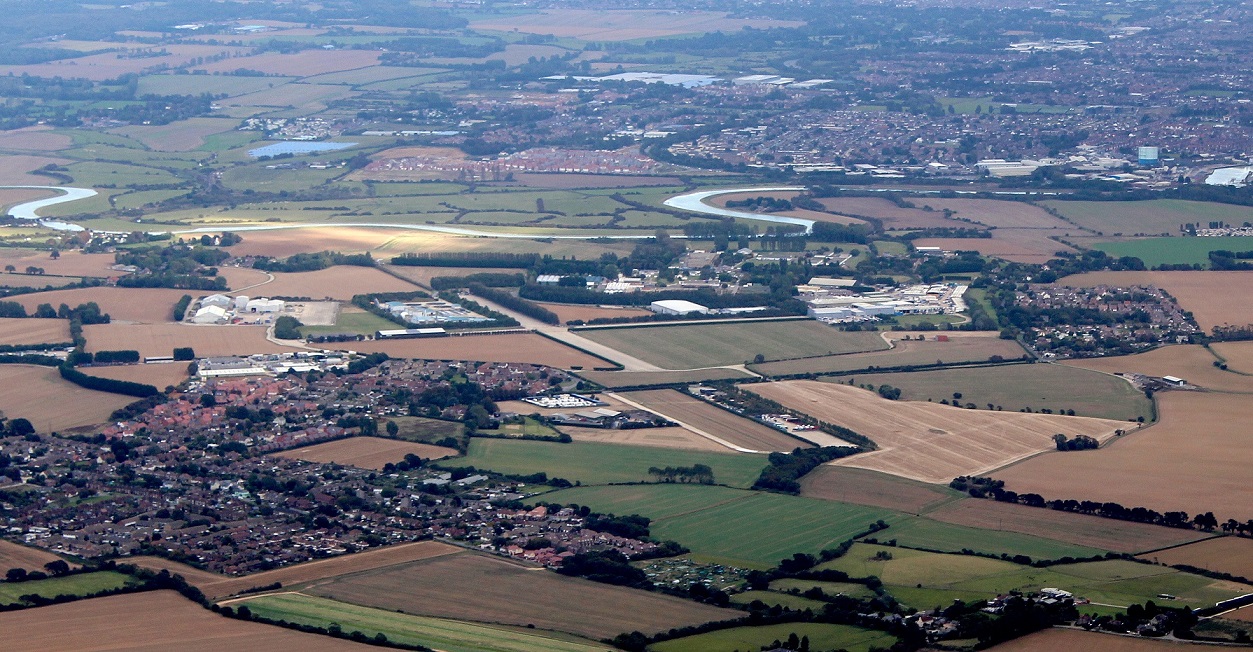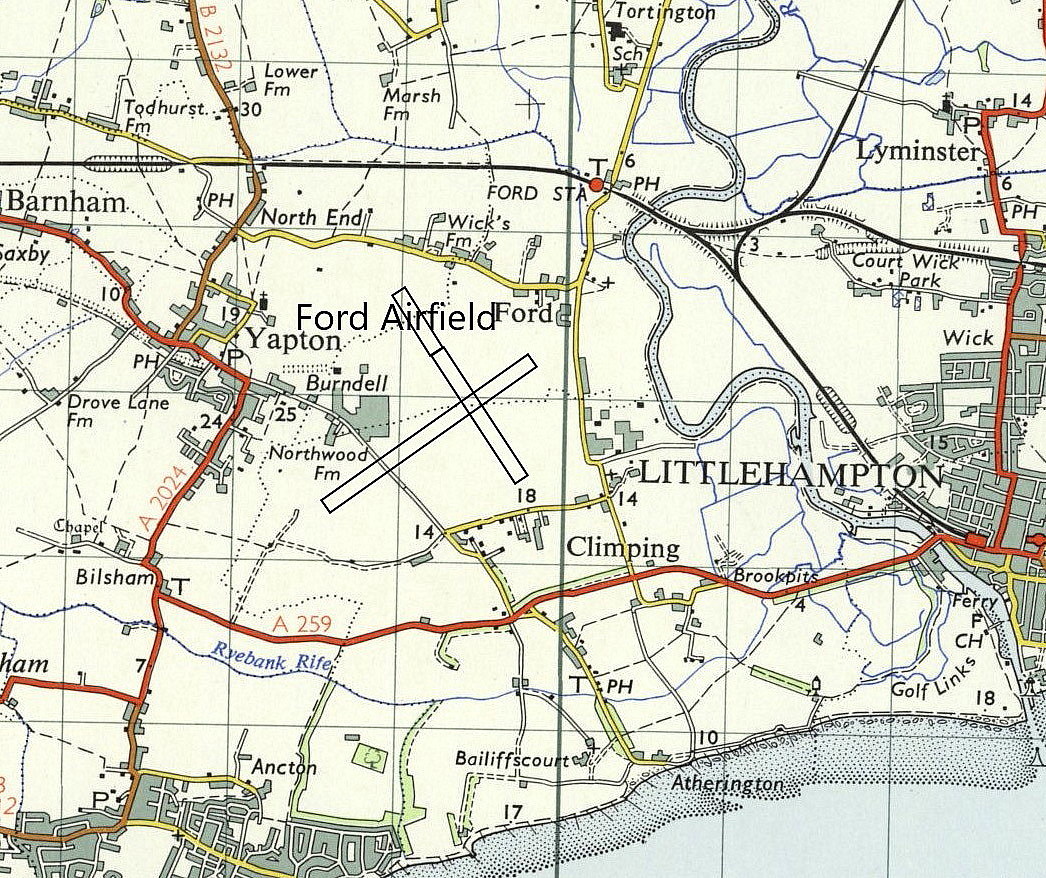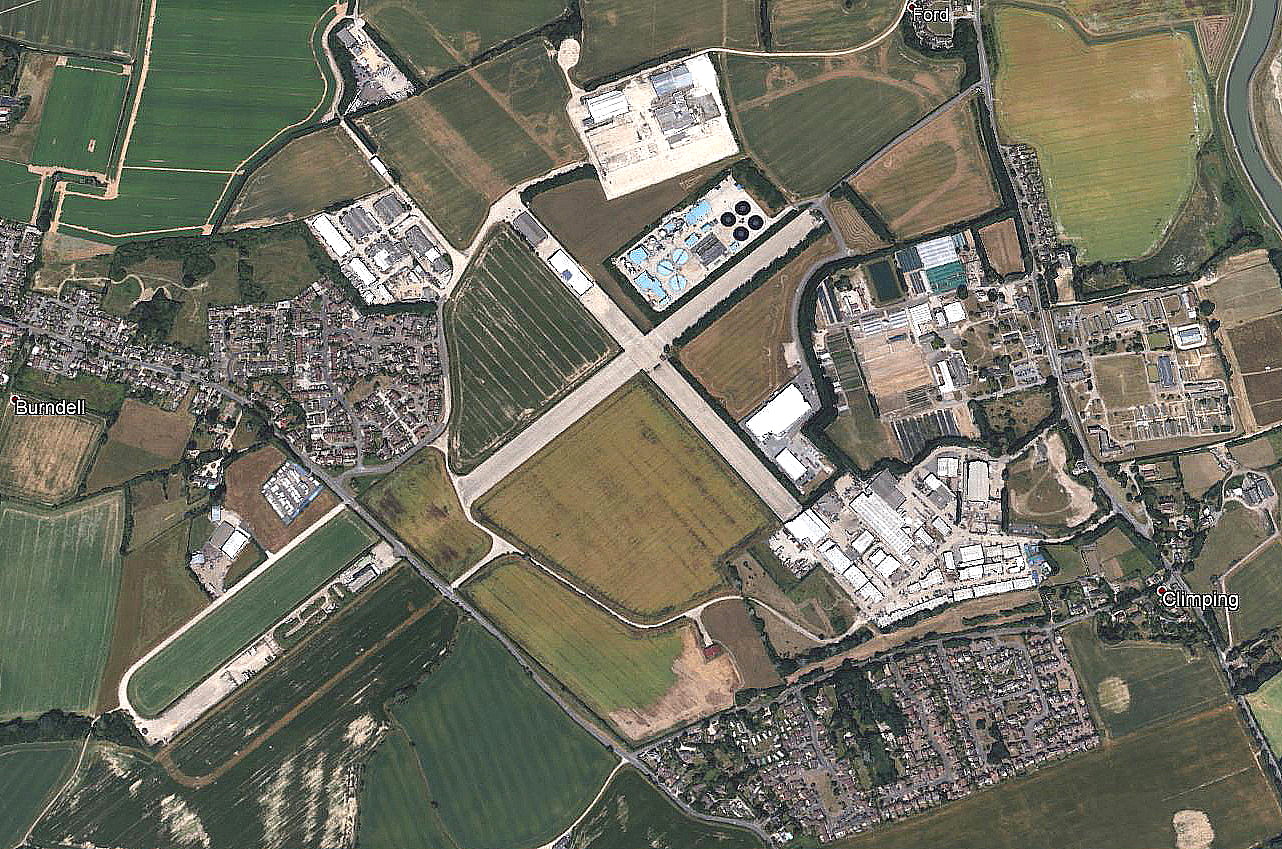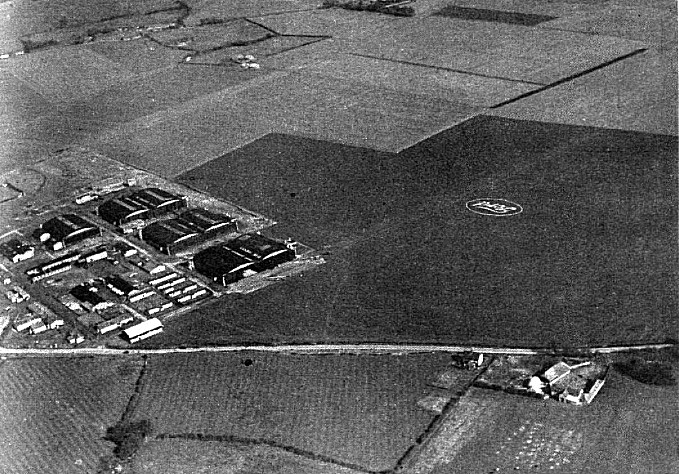Ford Junction
FORD JUNCTION: Military aerodrome, later civil aerodrome, then military aerodrome (WW2 RAF FORD)
Later Royal Naval Air Station (1948 HMS PEREGRINE). Later still civil/private aerodrome (Also known as YAPTON)
Note: All these pictures were taken by the author.The first picture was taken from an airliner, (at about 15 to 20,000ft?), which was departing from runway 26L at GATWICK in the early 2000s.
The second and third pictures were taken when flying past at a much lower altitude, (and through perspex) in the Diamond DA-40D G-CCFR during a check-flight from SHOREHAM.
Note: Both these pictures were also taken through perspex from a Piper PA-28 Cherokee.
Operated by: Pre 1940: Possibly the South Downs Aero Club, or Sussex Aero Club, or some say the Ford Motor Company
Military users: WW1: RFC/RAF Training Squadron Station (1918)
USAAS Training School (1918)
149 Sqdn* (F.E.2b’s – used for night bombing when transferred to France)
Note: The 1918 aerial photo was kindly provided by Mr Allen Misselbrook c/o the Yapton & Ford Local History Group. The two maps and Google Earth © view were kindly provided by Mr Michael T Holder.
Interwar years: RAF School (1919 to 1920)
WW2: Initially a RNAS Station
Later: RAF Fighter Command 11 Group
Forward Airfield - Night Fighter
604 Sqdn (Bristol Beaufighters)
23, 29, 96, 264, 410 (RCAF), 456 (RAAF) & 811** Sqdns (DH Mosquitos)
In the run-up to D-Day: 302, 306 & 308 (Polish) Sqdns (Vickers-Supermarine Spitfires)
315 (Polish) Sqdn (Mustangs) 331 (Norwegian) Sqdn (Spitfires)
1945-58 RN Fleet Air Arm
Service Trials Unit
746 Sqdn Fleet Air Arm (Fairey Firefly)
Scimitar Intensive Flying Trials Unit (Disbanded 1958)
Civil users: Pre 1940: Flight Refuelling, National Aviation Displays
Note: Both concerns operated by Alan Cobham.
Manufacturing: Post 1945: Miles Engineering (1964? to 1971)
Flying Club: 1930s: South Downs Aero Club, Sussex Aero Club, Yapton Flying Club
Post 1945: Ford R.N.V.R. Flying Group, Peregrine Air Group
Note: In the 1957 The Aeroplane directory, the Ford R.N.V.R. Flying Group are listed as operating two DH82A Tiger Moths.
Also listed were the Peregrine Air Group operating one DH82A Tiger Moth. Membership was restricted to Ford R.N. Air Station personnel.
Location: E of Yapton, SW of Ford, N to NW of Climping & 2.5nm NW of Littlehampton
Period of operation: Military 1918 to 1958 then civil to 1971only?
Site area: WW1+: 145 acres 869 x 777
Runways: 1944: 06/24 1829x46 hard 15/33 1463x46 hard
(The runway surfaces were tarmac & wood chippings - a stupid combination at best!)
FORD was also most unusual in WW2 for only having two hard runways laid out.
Note: When laid out the 06/24 runway bisected the B2233 road. There are many examples in WW2 of runways cutting off roads, sometimes quite major roads. At that time the air war took precedence over all other considerations, but one can easily imagine how incensed the local people must have been.
NOTES: *149 Sqdn had a quite remarkable career in the RAF, remaining as a night bomber squadron from 1918 until disbanded in 1956. (According to Wikipedia)
THE FORD CONNECTION
Some people reckon the aerodrome was named after the Ford Motor Company but this is certainly not the case. It was named after Ford Junction village nearby. The Ford Motor Co did however lease part of the aerodrome, (from July 1931 to 1933 only?) as the base for their Trimotor aircraft and had their famous elliptical ‘Ford’ Motor Company trademark symbol clearly marked out on the aerodrome surface. It appears that Ford had two Trimotors based here, the 4-AT-E G-ABEF and the 5-AT-C G-ABFF which were imported by sea, (to Liverpool?), and assembled at HOOTON PARK (CHESHIRE) in 1930.
Note: These two pictures from Flight magazine were kindly provided by Mike Holder. In the detail are two aircraft, these being: G-AACO and G-ABBK, both de Havilland DH60G Moths. The 'Ford' symbol can be seen on the grass in the first picture.
DUDLEY WATT
Ron Smith in British Built Aircraft Vol.3 states: “In 1928 or 1929, Mr Dudley Watt was making use of the aerodrome, and he and Mr J.E. Dorran-Webb formed the Sussex Aero Club there in 1930.” He also states that the DW Aircraft Co. were based here with the Dudley Watt DW2 G-AAWK and that he also operated three Avro 504Ks for joy-riding.
FLYING CIRCUS VENUE
The 1932 itinerary of Alan Cobham’s National Aviation Day UK Display Tour gives the 104th venue address as Ford Aerodrome, Yapton, Littlehampton. On the 15th August 1933 Ford was a venue for Cobham’s No.1 Tour of the UK. FORD was also the winter maintenance and overhaul base for the Sir Alan Cobham NAD (National Aviation Day) fleet from 1932 to 1935, although some say this was only from 1934?
FLIGHT REFUELLING
Reading the history it really is quite astonishing that this idea ever got beyond the concept stage, and I think that most will agree that only somebody with the huge drive, connections and sheer guts such as Alan Cobham could have succeeded. Air to air refuelling tests were carried out from FORD in 1936 by Flight Refuelling Ltd, owned by Sir Alan Cobham. In British Built Aircraft Vol.3 Ron Smith gives the following details: “Flight Refuelling moved their operations to Ford on 1 January 1936 (although Sir Alan Cobham’s National Aviation Tour fleet had made use of the site since 1932).” The company was originally formed and based at PORTSMOUTH (HAMPSHIRE) from late 1934. “In its pioneering work, Flight Refuelling operated an extraordinary variety of aircraft, including two Vickers Virginia, Fairey Hendon, Armstrong Whitworth AW.23 G-AFRX, Handley Page Heyford, HP.33 Clive G-ABYX, HP.51 J9833 and a HP.54 Harrow.”
OXFORD UNIVERSITY AIR SQUADRON
It appears that in the late 1930s the Oxford UAS (then based at ABINGDON (BERKSHIRE), held some of their summer camps here and in one year, at least, had three Hawker Harts, two Hawker Hinds, one Hawker Audax and fourteen Avro Tutors available.
WORLD WAR TWO
In WW2 FORD had another distinction in having the only squadron equipped with the naval version of the Mosquito. To quote from Robert Jackson in his book Britain’s Greatest Aircraft : “In June 1943, a variant of the Mosquito was proposed to meet Specification S.11/43, calling for a torpedo-reconnaissance fighter/fighter bomber. This emerged as the TR.33, a deck-landing version of the Mk.VI, with upward-folding wings, and arrester hook, four-blade propellers, oleo-pneumatic landing gear, American ASH radar in a thimble nose, JATO gear, four 20mm cannon and provision for an under-belly 2,000lb Mk.XV or XVII torpedo, or alternatively a bomb or mine. Mosquito FB.Vs LR359 and LR387 became the TR.33 prototypes, the first carrying out deck landing trials on HMS Indefatigable in March 1944.”
In July 2013 a TV programme on Channel 4 was dedicated to the Mosquito, and typically by the producers given the ridiculous name; The Plane That Saved Britain. But of course it often does appear that you cannot usually become a radio, TV or film producer it you have had any worthwhile education or having a clue about the subject in hand. You have to be, (from my experience), invariably an absolute fool – which seems a strange qualification? Or is this being a tad too cynical? Despite this the programme did include many valuable and interesting insights; not least an interview with the famous and fabulous test pilot Eric ‘Winkle’ Brown who made the first carrier deck landings with a Mosquito. As he pointed out, given the very high landing speed of the Mosquito, the exercise was viewed by most as being tantamount to suicidal; but he appears to have completed the sorties with relative ease!
Eric ‘Winkle’ Brown was of course in his professional career years a truly exceptional pilot, amongst the best this country has seen. I attended a lecture he gave when he must have been in his eighties, and he was still sharp and quick witted. Perhaps oddly (?) he didn’t include the deck landings with a Mosquito in the lecture, so presumably didn’t consider them as being a significant part of his flying career. Getting back to the story: “Two more aircraft, TS444 and TS449, undertook handling trials, these being followed by fifty production aircraft: forty-seven more were cancelled later. The only squadron to equip fully with the TR.33 was No.811 at Ford, Sussex, in 1946; it relinquished them a year later.”
I have to admit I had no idea about the TR.33 version of the Mosquito until researching this Guide – and have considered myself to being a pretty big fan of the type, not least because I had an uncle flying the type on Pathfinder missions in WW2.
MORE INFO ON FLIGHT REFUELLING
It is, I think, seeing how commonplace it is today in military operations, rather hard to imagine just how revolutionary and difficult it was in those early days to develop air-to-air refuelling techniques and procedures? I believe it correct to say that Flight Refuelling were the first to pioneer this method in the world? Ron Smith goes on to say: “The Harrow tankers, G-AFRG, G-AFRH and G-AFRL were used for experimental fuel transfer to Short C Class flying boat receiver aircraft including Cabot, Cambria and Caribou.” G-ADUV Cambria was a S.23 ‘C’ class flying boat whereas G-AFCU Cabot and G-AFCV Caribou were S.30 ‘C’ types.
Ron Smith then explains: “Sixteen transatlantic flights were completed in autumn 1939, with C - Class flying boats being refuelled by Harrow tankers based in Shannon and Newfoundland.” Sounds simple enough stated like this? From my point of view as a private pilot how on earth did they manage to arrange these mid-air rendezvous in those days? They had no radar on board, no radar steers from ATC etc. The navigators must have been absolutely first class? Again from Ron Smith; “Work on the development of flight refuelling techniques was continued after the war in conjunction with British South American Airways using Avro Lancaster/Lancastrian aircraft.
The first non-stop BSAA Lancaster flight from London, (My note: From HEATHROW I would say?), to Bermuda commenced on 28 May 1947. The route was flown by Lancaster G-AHJV, flown by Air Vice-Marshall D.C.T. Bennett of BSAA, and refuelled by one of Flight Refuelling’s Lancaster tanker aircraft G-AHJW, flying from the Azores.” Just for the ‘anoraks’, to whose ranks I hope to aspire, the Flight Refuelling tanker Lancaster fleet was; G-AHJT, G-AHJU, G-AHJV, G-AHJW and G-AHVN. It must be remembered that Flight Refuelling moved to TARRANT RUSHTON (DORSET) in June 1948. The company had Lancaster XPP tanker conversions G-AKDP, G-AKDR and G-AKDS based at ‘tanker stations’ to support the tests and also the Consolidated B.24 Liberator G-AHYD in a trial lasting from the 4th February to the 28th May 1948.
Being very nerdy it appears the company acquired four more Lancasters, G-AKAJ, G-AKAK, G-AKAL and G-AKAM but after a ferry flights to TARRANT RUSHTON these were dismantled for use as spares. For more info read British Built Aircraft Vol.3 by Ron Smith who mentions: “Flight Refuelling Ltd also operated Lancaster XPP G-AKDO. The Lancaster XPP was a civil transport conversion of the Avro Lancaster, produced in Canada by TCA and Victory Aircraft Ltd. The type had extended nose and tail fairings, and was superficially similar in appearance to a Lancastrian. Lancastrians operated by Flight Refuelling Ltd included G-AGWI, G-AKFF, G-AKFG and G-AKTB. Avro Lincoln RA657 was used for the development of the probe and drogue refuelling system, which the UK eventually adopted for military use.”
THE LARGEST AIRCRAFT TO VISIT FORD?
In his fabulous memoirs, 'A Time to Fly', he tells us that despite very encouraging trials after WW2, Flight Refuelling failed to get any positive responses, and indeed the future of the company looked very precarious. Looking back it seems incredible now, but the Air Ministry and the RAF were showing no interest at all.
"It was the Americans who saved us. In 1948, with the tensions and dangers of the Cold War, they were very worried to realize that they didn't possess a bomber with intercontinental range. It would take seven years or so to produce such a bomber, and they wanted it now. But General Doolittle was on the relevant committee, and he proposed flight refuelling as the answer, naming us as the people who knew all about it, and were already doing it successfully."
"In April, therefore, a B.29 landed at Ford and brought us a somewhat high-handed colonel who more or less told us to put our equipment and technique at the disposal of the U.S.A.F. We told him politely that these things cost money and that we were a commercial firm; if the United States wanted to do business, let the United States talk business. So proper negotiations began, and before Easter we had a contract worth a million and a quarter dollars, and this was only the beginning."
I suppose this incident reflects how the U.S.A. was viewing the U.K. after WW2. Basically as a vassal State, which in effect we were. American commercial interests were pouring in to grab as much as they could - and who can blame them? For example, Ford and General Motors (Vauxhall) for vehicle production. Kelloggs, Nabisco and Kraft in the food market. Esso and Texaco in fuel supplies. It's a long list.
Getting back to the B.29 landing here, am I wrong in thinking the Boeing B-29 Superfortress was, at that time, the largest fully operational bomber in all the Allied air forces?
THE MILES CONNECTION
In the 1960s Miles Engineering was set up here by F G Miles after he left Beagle at SHOREHAM and produced three replica Bristol Boxkites for the film ‘Those Magnificent Men in their Flying Machines’ and two SE5As for the film ‘Blue Max.’
Today, as is so often the case with many famous aerodromes, it is home to a HM Prison.
Russell Vallance
This comment was written on: 2017-08-07 09:50:53Though records are frustratingly sparse, it would seem that 746 Squadron FAA operated from Ford in 1945, possibly earlier, with Fairey Firefly night fighters against the V1s, (less one flight detached for carrier operations off Norway). Though the V1 launch sites had been overrun by then, the Germans had adapted them to be air launched from Heinkel bombers against London. Stationing of FAA squadrons on RAF bases is often not obvious because the Navy insisted on paying them through the nearest Naval station, hence the units stationed at Ford (and probably Tangmere as well) were officially at "HMS Daedalus" at Lee on Solent. A comment from the time mentions that RAF personnel were issued with kfs sets, whereas cutlery was provided in Navy messes. FAA personnel on an RAF station could therefore find themselves with plates of hot food and nothing to eat it with!
Reply from Dick Flute:
Hi Russell, Many thanks for this information which I shall keep posted. Best regards, Dick
Pat Pond nee Upstone
This comment was written on: 2017-08-15 14:26:49My father Dennis Upstone joined Flight Refuelling at Ford West Sussex after the war. Moving with them to Tarrant Rushton Dorset.
Reply from Dick Flute:
Hi Pat, Many thanks for getting in touch. Would you happen to have any pictures? Best regards, Dick
Paul Brooker
This comment was written on: 2018-01-10 21:57:31My Uncle and his crew crash landed a Stirling in the early hours of D Day somewhere near Ford. They were badly shot up near Pegasus Bridge, Normandy, losing two engines and two crew. I am told a picture exists of the crashed aircraft but I have never seen it. If anyone knows of a copy I would love to see it. brookeratheber@btinternet.com
Reply from Dick Flute:
Hi Paul, I shall keep this request posted, and hopefully somebody can help. Best regards, Dick
Allen Misselbrook
This comment was written on: 2018-01-31 23:06:30If anyone is interested we are organising an exhibition to commemorate the centenary of Ford Airfield this coming June. To clear up the point about the flying clubs, In June 1932, Rollason Aviation Ltd. moved their flying school down from Croydon and operated under the name of Southdowns Flying Club which soon changed its name to Yapton Areo Club. Possibly the most famous person to learn to fly there was Lettice Curtis, the Air Transport Auxillary pilot of WW2,
Reply from Dick Flute:
Hi Allen, Many thanks, I shall keep this posted. Best regards, Dick
Allen Misselbrook
This comment was written on: 2018-02-19 08:51:34A message for Pat Pond I am very interested to read that your father joined Flight Refuelling at Ford after WW2.. All my information is that the company moved to Tarrant Rushton before the war. I would appreciate any information you might like to share so that I can update my records. Allen
J.Hartley Watlington
This comment was written on: 2018-03-02 00:25:50At 0210hrs on 22June 1943 my father Fl Lt J H Watlington ( of Bermuda) took off from Ford aerodrome in a Mustang Mk.1 on night patrol against enemy fighter bombers. The primary target was an aerodrome near Amiens... with locomotives as a secondary target. While attacking a locomotive east of Amiens he ran into a barrage of light tracer flak and was hit in the radiator. He flew off at low level and once out of danger he climbed to 9000 ft in order to bale out and abandoned the aircraft at 0315 hours...coming down in the middle of a high field of corn about 20 kms north of Neufchâtel. After hiding his parachute and mae west in the corn he started running south east,continuing til an hour after daylight, and then hid in a tree-covered hill where he slept til noon. He then embarked on a rather long and arduous journey that crossed France three times while being hunted by the gestapo ...managing to evade capture via a fair amount of sheer luck and the enormously courageous help of innumerable members of the French Resistance. After eleven months, he finally was able to cross over the border into Spain via the Pyrenees with a group of other evaders including 11 Dutchmen,2 Frenchmen,1 Belgian and 15 Americans ...including Chuck Yeager ( the noted US post war test pilot featured in the 1980s book "The Right Stuff" by author Tom Wolfe). He eventually arrived in Gibraltar by train a few days after it departed from Madrid on 19 May,1944. The above was mainly taken from a report of his official debriefing after arriving back in England from Gibraltar. Years later all four of his children in Bermuda were sent over to boarding school in southern England. I was first at Newells Prep School near Horsham , Sussex and then at Seaford College near Petworth for O and A levels ....where I was vaguely aware that Ford aerodrome was somewhere down the road not too far away.
Reply from Dick Flute:
Many thanks indeed. What a fabulous story - much appreciated. Best regards, Dick
We'd love to hear from you, so please scroll down to leave a comment!
Leave a comment ...
Copyright (c) UK Airfield Guide

























